
Perth is a centrally located Scottish city, on the banks of the River Tay. It is the administrative centre of Perth and Kinross council area and is the historic county town of Perthshire. It had a population of about 47,430 in 2018.

Newlands House is an historic building in Bridgend, Perth and Kinross, Scotland. Located on Main Street, it is a Category B listed building, built around 1810.

Dunkeld is a town in Perth and Kinross, Scotland. The location of a historic cathedral, it lies on the north bank of the River Tay, opposite Birnam. Dunkeld lies close to the geological Highland Boundary Fault, and is frequently described as the "Gateway to the Highlands" due to its position on the main road and rail lines north. Dunkeld has a railway station, Dunkeld & Birnam, on the Highland Main Line, and is about 25 kilometres north of Perth on what is now the A9 road. The main road formerly ran through the town, however following the modernisation of this road it now passes to the west of Dunkeld.

Charing Cross is a major road junction and area within the centre of Glasgow, Scotland. It is situated north of the River Clyde at the intersection of Sauchiehall Street, St George's Road, Woodlands Road, North Street and Newton Street, as well as being at a major interchange of the M8 motorway. Charing Cross marks the notional boundary between the City Centre and the West End of the city.

Perth Bridge is a toll-free bridge in the city of Perth, Scotland. A Category A listed structure, it spans the River Tay, connecting Perth, on the western side of the river, to Bridgend, on its eastern side, carrying both automotive and pedestrian traffic of West Bridge Street. An earlier bridge was demolished at the same location in 1621, and many unsuccessful attempts were made to replace it. A subscription was started by James VI and several noblemen to help with the construction cost, but the king's death in 1625 suspended the scheme and a series of ferryboats were instead used.

The Municipal Buildings are a municipal facility at Nos. 1, 3 and 5 High Street, Perth, Scotland. The facility is a Category B listed building.
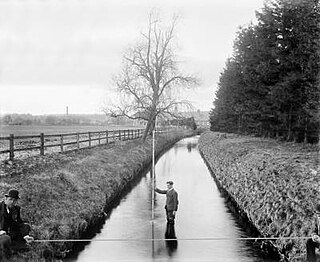
Perth Lade is an historic 4.5 mi (7.2 km)-long watercourse in Perth and Kinross, Scotland. Created in the 11th century or earlier, it has been used to power several watermills, such as those that functioned at Perth's Lower City Mills, which have existed since the 18th century. Over its course, at least nineteen industrial sites existed; today, the remains of nine of these can be seen, the rest lost to inner-city development and housing schemes of the 20th and 21st centuries. A footpath follows the majority of the lade's course.

South Inch is a large public park in Perth, Scotland. About 31 hectares in size, it is one of two "Inches" in Perth, the other being the larger, 57-hectare (140-acre) North Inch, located half a mile across the city. The Inches were granted to the city, when it was a royal burgh, by King Robert II in 1374. Both Inches were once islands in the River Tay. The two Inches are connected by Tay Street.

The Royal George Hotel is a hotel and restaurant in Perth, Scotland. It is a Category B listed building dating to 1773. Its main entrance is on George Street, though its Tay Street frontage, overlooking the River Tay, is more well known. It is named for George III.
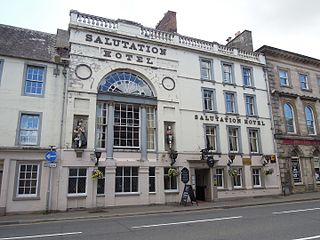
The Salutation Hotel is a hotel and restaurant in Perth, Perth and Kinross, Scotland. It is a Category B listed building dating to around 1810, with earlier embellishments and later alterations. It is said to be the oldest hotel building in Scotland. It has expanded to occupy three neighbouring tenements, one to the right and two to the left.

The vennels of Perth are a collection of small medieval streets in the city of Perth, Scotland. Similar to York's Snickelways, vennels are a public right-of-way passageway between the gables of buildings which can, in effect, be a minor street. In Scotland, the term originated in royal burghs created in the twelfth century, the word deriving from the Old French word venelle meaning "alley" or "lane". Unlike a tenement entry to private property, known as a "close", a vennel was a public way leading from a typical high street to the open ground beyond the burgage plots. The Latin form is venella, related to the English word "funnel".

26 Tay Street is an historic building in Perth, Scotland. Designed by local architect Andrew Heiton, the building is Category B listed, dating to around 1873. Standing on Tay Street, between St Matthew's Church to the south and the Perth and Kinross Council offices at 2 High Street to the north, the building is currently the home of The Capital Asset, a J D Wetherspoons establishment.
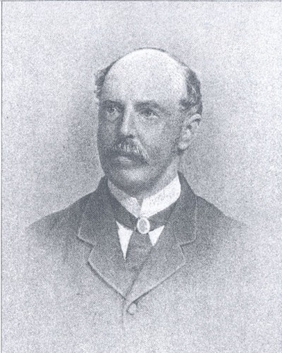
Andrew Heiton was a Scottish architect. He designed several notable buildings in Scotland, mostly railway stations and country houses.

Tay Street is a major thoroughfare, part of the A989, in the Scottish city of Perth, Perth and Kinross. Planned in 1806 and completed around 1885, it is named for the River Tay, Scotland's longest river, on the western banks of which it sits. The street runs from the confluence of West Bridge Street and Charlotte Street in the north to a roundabout at Marshall Place and Shore Road in the south. Three of the city's four bridges that cross the Tay do so in this stretch : Perth Bridge, Queen's Bridge and the single-track Tay Viaduct, carrying Perth and Dundee trains to and from Perth railway station, located 0.5 miles (0.80 km) to the north-west.

High Street is a street and the primary retail area of the Scottish city of Perth. Established in at least the 15th century, its central section has been both modernised and pedestrianised, while its two ends are mainly Victorian in terms of their composite buildings. It runs for about 0.5 miles (0.80 km), from Tay Street in the east to Caledonian Road in the west.
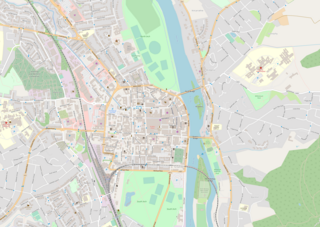
The A989 is a road in Perth, Scotland. Also known as the Perth Inner Ring Road, due to its circumnavigation of the city centre, it is 1.93 miles (3.11 km) long. Perth's city centre is around 0.5 miles (0.80 km) long and wide. The road was constructed around 1985.
Graeme Pallister is a Scottish chef and restaurateur from Blairgowrie, Perth and Kinross. He is currently owner and chef patron at 63 Tay Street and chef patron at No.1 The Bank, both in Perth. His cooking career began in 1994 at Kinloch House Hotel. From there, he went on to work at Angel, in Sussex; Longueville Manor, in Jersey; Let's Eat, in Perth; and Restaurant Andrew Fairlie, near Auchterarder. He began at No.1 The Bank in June 2005, and opened 63 Tay Street in January 2007. Ten years later, 63 Tay Street was named "Scottish Restaurant of the Year" at the Scottish Food Awards. On a personal level, he has won Scottish Hotel Awards' "Executive Chef of the Year" (2010) and Catering in Scotland's "Chef of the Year" (2013).
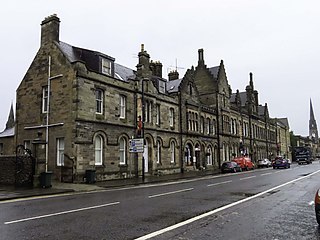
62–72 Tay Street is an historic row of buildings in Perth, Scotland. Designed by local architect John Young, the building is Category B listed, dating to 1881. Standing on Tay Street, the building was originally the museum home of the Perthshire Society of Natural Science, constructed in memory of Sir Thomas Moncreiffe, 7th Baronet, a past president of the society. The museum housed two exhibits: a local collection and The Type Museum, which illustrated the main types of animals, plants and rocks.

Marshall Place is a prominent street in the Scottish city of Perth, Perth and Kinross. Commissioned in 1801, and today part of the A989, the Perth Inner Ring Road, it runs for about 0.23 miles (0.37 km), from a roundabout it shares with Tay Street and Shore Road in the east to a convergence with King's Place in the west.




















